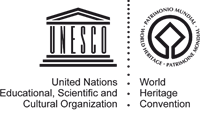
“...deterioration or disappearance of any item of the cultural or natural heritage constitutes a harmful impoverishment of the heritage of all the nations of the world...”
Preamble of the 1972 UNESCO Convention
The Convention for the Protection of the World Cultural and Natural Heritage was adopted by the General Assembly of the member-states of UNESCO in 1972 and up to date, 195 countries have ratified the Convention. The most significant feature of the 1972 World Heritage Convention is that it binds in a single document the concepts of nature conservation and the preservation of cultural properties and sets out the duties of member-states and the international community for the preservation of monuments of world heritage.
The Convention defines the responsible body, an Intergovernmental Committee, for taking decisions and evaluating requests for inscription on the World Heritage List.
Moreover, through the World Heritage Fund, that includes compulsory and voluntary contributions from the States Parties, as well as from private donations, the Committee supports activities, upon requests of States Parties in need of international assistance. The terms and conditions for financial assistance are defined in Operational Guidelines for the implementation of the Convention.